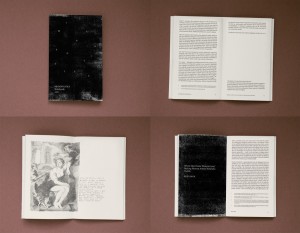MICROPOLITICS Notebook 2011
On Niches and In-Between Spaces
 This publication brings together texts by the lecturers hosted in the series Micropolitics in 2011 which focused on exploring niches, those in-between spaces between galleries, museums and so-called off-spaces, as spaces of production, communication, research, discussion and distribution of contemporary art. By bringing together their essays, works and notes, it does not strive for the comprehensive overview, but rather functions as a document or notes on what has been discussed in the framework of the series in 2011, and so it circles around the topic, tackling it from different viewpoints and through different formats.
This publication brings together texts by the lecturers hosted in the series Micropolitics in 2011 which focused on exploring niches, those in-between spaces between galleries, museums and so-called off-spaces, as spaces of production, communication, research, discussion and distribution of contemporary art. By bringing together their essays, works and notes, it does not strive for the comprehensive overview, but rather functions as a document or notes on what has been discussed in the framework of the series in 2011, and so it circles around the topic, tackling it from different viewpoints and through different formats.
The opening work by Clare Butcher explores the idea of the borderline as a site of unlikely connectedness, approaching the ambiguous terms of “fence” and “wall” in the particular context of South Africa. Katharina Schlieben reflects on some approaches of the project series Work to do! Self-organisation in Precarious Working Conditions that “examined the dynamics, emancipatory movements, and self-empowerment potentials as well as the paradoxes and problems of self-organisation concepts in times of huge transformations of working conditions in our society”. In her essay, Beata Hock analyses art works and network activities from the 1970s that have so far remained blurred in recent art history narratives, as they were mostly focused on the rehabilitation of the male-dominated counter-culture of the period. Her findings are insofar more valuable because the assessment of women artists’ activities in the Central and South Eastern European region from a feminist perspective has been characterized by a “discourse of lack”, each country typically exposing one lonely early feminist “heroine” at best. In the context of complicity between the world of artistic research and the neoliberal economic and political regimes, Nataša Petrešin-Bachelez calls for the renewal of research by encouraging and maintaining the construction of methods through situated actions. The Bureau for Melodramatic Research usually relies on methodology of infiltrating into cultural institutions at home and abroad “in order to de-mystify the function of gendered emotional capital in the matrix of social, political and economic relations that govern these organizational bodies”. In the debate with art historian Corina L. Apostol they address the conditions of inequality that direct the reception, interpretation and production of art and culture by women on Romanian art scene today.
This publication also brings Iva Kovač and Elvis Krstulović’s drawings, as continuation of their long-term project Art&market that examines the relations of art and power positions. This simple gesture of opening the Notebook as an in-between space for exhibition changes the status of the publication and calls for altered perception. (V.V.)